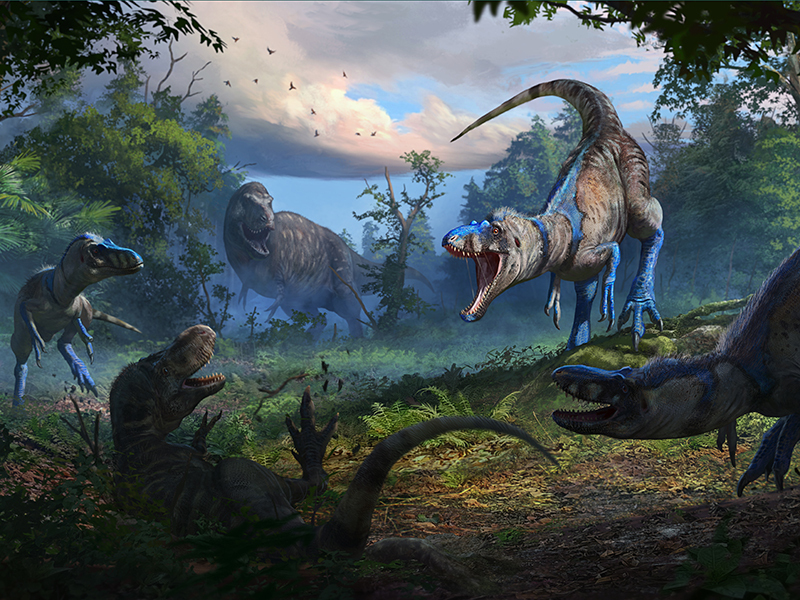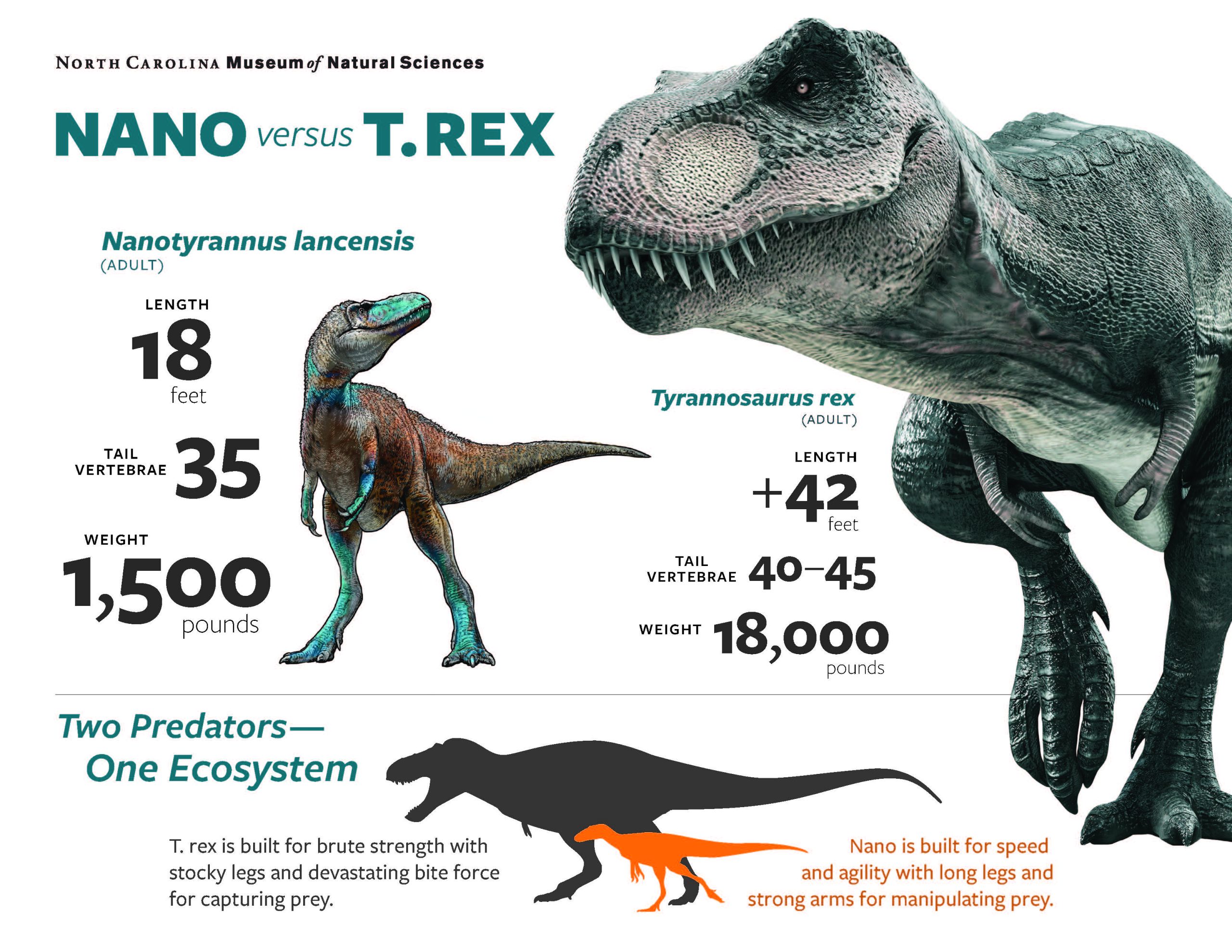Nanotyrannus Confirmed: Dueling Dinosaurs Fossil Rewrites the Story of T. rex
For immediate release ‐ October 30, 2025
Contact: Jon Pishney, 919.244.7913. Images available upon request

What if everything we know about T. rex growth is wrong? A complete tyrannosaur skeleton has just ended one of paleontology’s longest-running debates – whether Nanotyrannus is a distinct species, or just a teenage version of Tyrannosaurus rex.
The fossil, part of the legendary “Dueling Dinosaurs” specimen unearthed in Montana, contains two dinosaurs locked in prehistoric combat: a Triceratops and a small-bodied tyrannosaur. That tyrannosaur is now confirmed to be a fully grown Nanotyrannus lancensis – not a teenage T. rex, as many scientists once believed.
“This fossil doesn’t just settle the debate. It flips decades of T. rex research on its head,” says Lindsay Zanno, head of paleontology at the North Carolina Museum of Natural Sciences, associate research professor at North Carolina State University and co-author of the study published in Nature.
Using growth rings, spinal fusion data and developmental anatomy, the researchers demonstrated that the specimen was around 20 years old and physically mature when it died. Its skeletal features – including larger forelimbs, more teeth, fewer tail vertebrae, and distinct skull nerve patterns – are features fixed early in development and biologically incompatible with T. rex.
“For Nanotyrannus to be a juvenile T. rex, it would need to defy everything we know about vertebrate growth,” says James Napoli, anatomist at Stony Brook University and co-author of the study. “It’s not just unlikely – it’s impossible.”
The implications are profound. For years, paleontologists used Nanotyrannus fossils to model T. rex growth and behavior. This new evidence reveals that those studies were based on two entirely different animals – and that multiple tyrannosaur species inhabited the same ecosystems in the final million years before the asteroid impact.
As part of their research, Zanno and Napoli examined over 200 tyrannosaur fossils. They discovered that one skeleton, formerly thought to represent a teenage T. rex, was slightly different than the Dueling Dinosaurs’ Nanotyrannus lancensis. They named this fossil a new species of Nanotyrannus, dubbed N. lethaeus. The name references the River Lethe from Greek mythology – a nod to how this species remained hidden in plain sight and “forgotten” for decades.
Confirmation of the validity of Nanotyrannus means that predator diversity in the last million years of the Cretaceous was much higher than previously thought, and hints that other small-bodied dinosaur species might also be victims of mistaken identity.
“This discovery paints a richer, more competitive picture of the last days of the dinosaurs,” Zanno says. “With enormous size, a powerful bite force and stereoscopic vision, T. rex was a formidable predator, but it did not reign uncontested. Darting alongside was Nanotyrannus – a leaner, swifter and more agile hunter.”
This work, published in Nature, was supported by the State of North Carolina, NC State University, the Friends of the North Carolina Museum of Natural Sciences, and the Dueling Dinosaurs Capital Campaign.
Note to editors: An abstract follows.
What if everything we know about T. rex growth is wrong?
Hear from Dr. Lindsay Zanno, head of paleontology at the North Carolina Museum of Natural Sciences, associate research professor at North Carolina State University and co-author of a new study published in Nature.
Nanotyrannus versus Tyrannosaurus rex

Nanotyrannus Plain Language Abstract
The most important dinosaur discovery of the decade is on display at the North Carolina Museum of Natural Sciences — and it’s rewriting the story of Tyrannosaurus rex.
The Dueling Dinosaurs fossil, found in Montana, contains two dinosaurs locked in prehistoric combat: a Triceratops and a small-bodied tyrannosaur. That tyrannosaur turns out to be the most complete skeleton ever found of Nanotyrannus lancensis — a dinosaur long debated as being either a distinct species or a teenage T. rex.
This fossil categorically ends that debate.
Nanotyrannus is not a juvenile T. rex. It belongs to a separate genus entirely — and one much more distantly related. The skeleton’s fusing spinal sutures and growth rings show it was fully grown when it died at ~ 20 years of age. Its anatomy reveals traits that form early in development and don’t change with age — including fewer tail vertebrae, more teeth, larger hands, and different skull nerve and sinus patterns. These differences make it biologically impossible for Nanotyrannusto grow into a T. rex.
The implications are massive. For decades, paleontologists have used Nanotyrannus fossils to study T. rex growth and behavior. This new evidence shows those studies were based on two entirely different animals. This discovery completely reframes the idea that T. rex was the lone predator of its time, challenging long-held assumptions about late Cretaceous ecosystem dynamics.
We now know multiple tyrannosaur species coexisted in the last million years before the asteroid impact— suggesting a richer, more competitive ecosystem than previously imagined. It’s a landmark moment for dinosaur science — and a defining achievement for Dr. Lindsay Zanno and the North Carolina Museum of Natural Sciences.
For more information about our upcoming activities, conservation news and groundbreaking research, follow @NaturalSciences on Instagram and Facebook.

